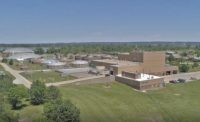As the population of Johnson County, Kan., grew, turning it into the most densely populated county in the Kansas City metropolitan area, its main wastewater treatment facility, the Tomahawk Creek Wastewater Treatment Facility in Leawood, failed to grow alongside it.
The plant, built in 1955, was able to treat up to only 19 million gallons a day, forcing burgeoning Johnson County to send most of its 450,000 citizens’ wastewater to neighboring Kansas City, Mo., (KCMo) for costly treatment. Tomahawk Creek could only treat about 150,000 local flushes.
“They had to do an economic event analysis,” says John Keller, project manager at engineer Black & Veatch. “Is it cheaper to build a new facility or continue to have KCMo treat our flow? That was the first phase of the project. If we built a new facility, how much would it cost? Then we compared that to if the flow went to KCMo. We did a life-cycle cost analysis, and it was cheaper to build the brand new facility—with the new permit and discharge into the Tomahawk Creek versus continuing flowing to KCMo.”
Over 35 years, the analysis showed that Johnson County would save $785 million by investing in a new plant rather than sending its waste to Kansas City. During the plant’s three-and-a-half-year construction timeline that began in 2018, Johnson County will send all its flow to Kansas City. Sewer rate charges will rise for residents during that time, but by 2022, rates will drop. The average sewer bill is around $35 a year.
The $335-million expansion and reconstruction will not only modernize the Tomahawk Creek Wastewater Treatment Facility and take its treatment capacity to 172 million gallons per day of wet and dry weather flows, it will also add flood protections that will help the plant deal with ever increasing rainy spring and summer seasons that otherwise could have contributed to sewer backups and overflows that may have potentially threatened the water supply. 19 mgd is the average daily design treatment capacity for the new facility. The previous treatment facility was only able to treat an average flow of 7 mgd.
“The existing plant was designed for a hundred-year flood event,” says Michael Kalis, vice president and water section manager for engineer HDR. “The plant was like an island when it flooded. We raised the whole site to the 500-year floodplain elevation to meet current regulations. By doing that we had to put in a channel to [Tomahawk Creek] that will alleviate any additional runoff or flooding that we may cause by raising the floodplain.”
Construction Management
Because of the complexity and tight schedule, and the fact that continuing costs for treatment in Kansas City would inflate the project’s overall cost if work wasn’t completed on time, Johnson County chose the construction manager at-risk delivery method and hired the Kansas City division of McCarthy Building Cos. as its CM, while Black & Veatch and HDR kept their engineering design team roles that predate the county’s decision to build.
The project includes Aqua-Aerobic disc filtration system installation, construction of more than 30 new structures on the site—requiring a 30% greater footprint than the previous plant—installation of more than 130 pumps, placement of 50,000 cu yd of concrete and placement of more than nine miles of underground utility infrastructure.
McCarthy is building influent junction and flow-control structures, a new peak flow pump station, a new headworks building, primary clarifiers, biological nutrient removal basins as well as final clarifiers and their associated pump stations and splitter structures. Construction also includes a tertiary pump station, a filtration complex, a chemical disinfection complex, an effluent reaeration structure, gravity thickeners, a solids process building that includes thickening and dewatering, solids digestion and gas storage structures, waste gas flares and a new administration and maintenance building. Very little of the original complex will remain, and McCarthy is using three tower cranes to manage the complex concrete construction that will last most of the project’s duration.
McCarthy’s fully owned subsidiary, Castle Contracting, is providing concrete services, making the project’s concrete all self-performed. The job required several high-strength mixtures for the facility’s new disc filtration tanks and carefully monitored curing for both the base placements and the tanks’ walls. Testing of all of the tanks for seepage is required later in the process.
“The key to self-performing is it allows us to control schedule as well as quality,” says B.J. Peterson, McCarthy’s project manager. “The mix design is extremely technical. It’s important that you get the proper consolidation, especially as it relates to the hydro testing that we have to do on all of the tanks. They have to hold water. So it’s incredibly important for us to be able to control all of those measures, curing and others, that go into that.
“That ultimately impacts schedule because down the road if there is any sort of issue, you’re adding time to try and investigate and figure out what the deal is,” he says. “We take a lot of pride in building a treatment plant and feel like it’s important to be able to control that risk.”
Tech Assist
McCarthy is using other measures to keep to the schedule such as regular drone flights to take real-time construction photos and measure progress and coordination. Trimble SX10 is being used to scan for accurate layout and Earthworks is being used for GPS-enabled heavy equipment placement and excavation measurement with sloping and location specificity. A 3D Autodesk Navisworks model of the entire site is being used to facilitate construction coordination and eliminate conflicts. The three tower cranes on site are operating a coordinated dance every day of construction. The CMAR method is allowing the engineering team to plan ahead for the project’s target completion in early 2022.
“The contractor schedule shows them that they’re on schedule, so we’ve switched to starting to develop the start-up plans for the project,” Kalis says. “We have the contractor getting in their operation maintenance manuals, and we are, right now, developing start-up plans of how we’re going to actually bring the treatment plant online because we’re starting the whole treatment plan up from ground zero.”
Heavy Rain … Then a Pandemic
One thing the design and construction team could not plan for, however, was the COVID-19 pandemic. Kansas never stopped construction on essential infrastructure such as the Tomahawk Wastewater Treatment Facility, so the schedule has not been impacted. McCarthy did, however, have to install new social distancing and monitoring protocols on the 60-acre site.
“We had over 300 workers on site, and they were already practicing the 6-foot social distancing,” Peterson says. “So the key is just making sure that everybody can come to work, they feel safe and keeping everybody 6 feet apart as much as possible on top of just additional cleaning measures and protective measures to make sure that we’re practicing the CDC guidelines around proper hygiene.”
A project with so much concrete placements made some work-arounds necessary for tasks such as monitoring the placement of concrete for the eight disc filter tanks with 24 filtration discs per tank.
“The key there is watching it closely and keeping people 6 feet apart as much as feasibly possible,” Peterson says. “In the event where somebody would have to work within 6 feet, that’s when we’re incorporating those extra measures, whether it be a face mask or a face shield, just to make sure that we’re protecting people. So if you were to go out there on a pour today, you would see that everybody has the extra PPE on just to make sure that everybody’s staying safe.”
The project keeps moving forward and is on schedule for 2022 despite the many challenges the last two years have brought.
“Last year we had the wettest year in Kansas from October to October,” Keller says. “We had almost 60 inches of rain. McCarthy dealt with the wettest year and when we continue on forward, it’s a pandemic this year. This is a lot of challenges.”












Post a comment to this article
Report Abusive Comment